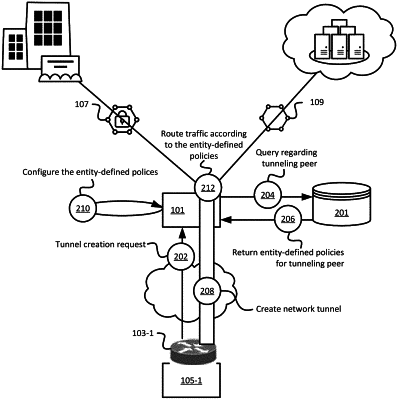| CPC H04L 47/2433 (2013.01) [H04L 12/4633 (2013.01); H04L 12/4641 (2013.01); H04L 47/2441 (2013.01); H04L 47/2483 (2013.01)] | 20 Claims |

|
1. A first device, comprising:
one or more processors configured to:
establish a first network circuit that includes a first set of network devices;
establish a second network circuit that includes a different second set of network devices;
establish a particular network tunnel with a second device, wherein establishing the particular network tunnel includes receiving a set of policies indicating whether to route egress traffic, received from the second device, to the first circuit or to the second circuit, wherein the set of policies include a particular policy indicating that traffic, that is received from the second device and is associated with a particular signature, should be routed via the first network circuit;
receive first egress traffic from the second device via the particular network tunnel;
identify that the first egress traffic includes the particular signature that is associated with the first network circuit;
select, based on the set of policies associated with the second device and further based on identifying that the first egress traffic includes the particular signature, the first network circuit for routing the first egress traffic;
route the first egress traffic via the first network circuit;
receive second egress traffic from the second device via the particular network tunnel;
identify that the second egress traffic does not include the particular signature;
select, based on the set of policies associated with the second device and further based on identifying that the second egress traffic does not include the particular signature, the second network circuit for routing the second egress traffic; and
route the second egress traffic via the second network circuit.
|